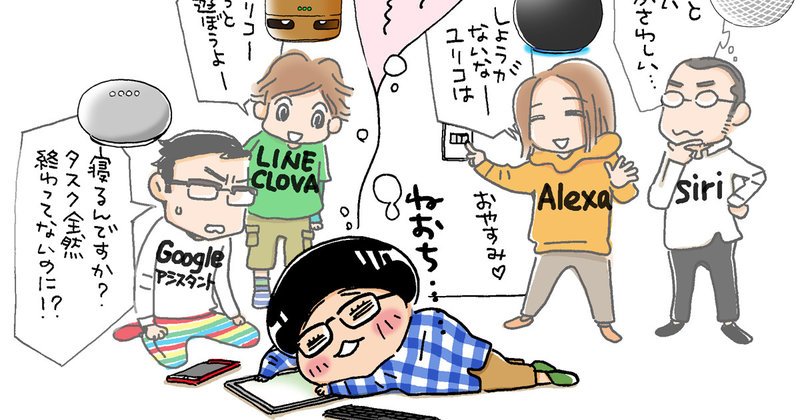I haven’t been good in the morning since I was a kid. I admired the “fully automatic wake-up machine” that I saw in science fiction anime. When the time comes, the bed gets up and brushes my teeth fully automatically. While I’m asleep, I change my clothes and eat and send them out.
Everything was a hassle, and to me, when I was thinking about “how to make things easier” every day, it seemed like an exquisite dream machine. Unfortunately, even after many years have passed since then, the fully automatic wake-up machine has not been commercialized. Still, thanks to IoT, it has become possible to get close to it. An electric toothbrush is like a mouthpiece that allows you to brush all your teeth at once on a bed that automatically reclines according to your sleep. If you say “Good morning,” the curtains will open, the air conditioner and lights will turn on, music will play, and the aroma of coffee will drift from the kitchen.
At the center of such connected home appliances, “smart speakers” are now. With smart speakers, home appliances can be operated just by talking! A “smart speaker” is a simple device with a microphone and speaker and can be connected to Wi-Fi, but it is also a dream machine where you can do various things just by “talking” with a voice AI assistant on the other side Internet.
The keyboard and mouse don’t even require touch operations like smartphones, so it’s perfect for a super-troublesome sneaker-like me.
When I first met Amazon’s smart speaker “Echo” and AI assistant “Alexa” at CES, the world’s largest digital trade fair, I was deeply moved by how home appliances move magically just by talking. By the way, Alexa-compatible fully automatic toilets have already been commercialized in the United States. It’s no wonder that a fully automatic wake-up machine is released anytime. It’s been a few years since the shocking encounter at CES, and now we have 12 intelligent speakers everywhere in our house.
The number of AI assistants has increased to four (!?) Not only Alexa but also Google’s “Google Assistant,” LINE’s “Clova,” and Apple’s “Siri.” It’s not fully automatic yet, but some home appliances can already be operated by voice. Thanks to you, like a strange woman who uses a lot of smart speakers, I also appeared on a TV program (* The world of smart speakers in “The World Unknown To Matsuko” aired on April 21, 2020).
The number of smart speakers in my house has increased to 12. I am
often asked, “How do you use a dozen smart speakers properly?” I wanted to be able to use intelligent speakers without any problems.
As a result of gradually increasing the number of places that can be used in the office, living room, bedroom, kitchen, and washroom, one of the intelligent speakers now responds to calls anywhere in the house.
Recently, in addition to speakers, devices equipped with displays, cameras, and radar sensors have joined the ranks, and we are also using such devices in the right place.
For example, a device equipped with a display and camera can display photos and make video calls like a digital photo frame, so it is installed on the desk so that you can talk with your family living away at any time. In addition, devices equipped with a display and radar sensor allow recipes to be easily viewed and gesture operations, so the kitchen is in a fixed position where hands tend to get wet, and touch functions are complex.
Even if voices reach multiple devices simultaneously, you can rest assured that the closest one will respond. However, sometimes I intended to set the timer in the kitchen, but the alarm sounds in the adjacent office. Sometimes it’s hard to stop because you don’t know which of the four AI assistants you asked to wake up. Well, thanks to that, I’m awake even in the morning when I’m not good at it, so living with a dozen intelligent speakers is very comfortable so far.
The four AI assistants can listen to my music, connect with my family living apart, and answer various questions. I was woken up by them, checking today’s weather, appointments, time to destination, listening to the news, doing radio calisthenics, learning recipes, and sometimes getting along with me to kill time. I am. Recently, the individuality of each AI has become more straightforward, and I have become more and more familiar with it.
Each individuality that smart speakers attract
This is just my image, but Alexa, for example, is an honor student type. I will try to respond to any unreasonableness. She (because her voice is feminine) has many friends = skills (extended functions that correspond to smartphone apps). She can enjoy karaoke and quizzes through her friends, and she is also good at operating home appliances. I can also shop like Amazon’s AI assistant, but sometimes I get sick of misordering.
Google Assistant is a secretary type. He (whose voice can be selected by gender, but I choose like) is good at searching and answers my poorly-carried questions while watching TV, such as “Is (talent name) single?” I will give you. He is also good at languages and can interpret any number of words. I have a perfect grasp of my schedule using Google Calendar, and he quickly answers me about the time required to travel, but he says that he can’t do what he can’t do, he can’t do it, and he doesn’t know.
Clova has excellent communication skills, such as being able to send and receive LINE by voice operation. Sometimes I suddenly start talking or play the music that is different from the request, which makes me surprised, but I can’t hate it.
Siri is good at music, partly because I like Apple Music. The “HomePod mini” I’m using is compact, but it sounds pretty good. The cooperation with the “iPhone” is precisely the breath of Aun, and along with the recently introduced “AirTag,” it also finds lost things in the house.
With the evolution of AI assistants, will someday be a dream machine?
All of them are evolving day by day, and they can do more and more. Traditional appliances have become obsolete over time, but AI assistants in the cloud are growing, so intelligent speakers can be said to be high-cost devices that can be used for a long time.
The number of home appliances that can be operated through them is increasing. As mentioned in the previous example, if you set in advance what are called “standard actions” or “routines,” you can move multiple home appliances with the word “good morning” can also do.
Even at home, when I say “good night,” the lights and TV are turned off, and the bed light is turned on instead. Just by muttering “good night” while tired, I can smoothly enter my dream. Once I lie down, I don’t want to get out of bed no matter what, so the ideal environment is built.
However, sometimes it doesn’t work. It seems that Alexa was in a bad mood just last night, and while I was calling, “Good night!” My throat became dry many times in bed, and my eyes became apparent, and I could not sleep.
Even if they try to make it easier like this, they do not make it easy. Still, one day, while dreaming of realizing a dream fully automatic wake-up machine, in this short-term serialization, only one point is how to make it easier with digital products. I want to pursue. Please keep in touch with me for a while.
Author: Yuriko Ota Yuriko Ota Tech writer and editor. Since the dawn of the Internet, he has been involved in the launch of Web direction, Internet-related free papers, and information magazines. Since then, he has continued his coverage and writing activities focusing on familiar digital gadgets, various services, applications, and related businesses that can be used through them, from personal computers, mobile phones, smartphones to wearable devices and IoT devices.











